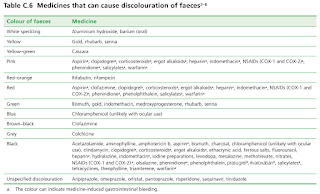Medicine-induced Discolouration
Introduction
A customer walking to your community pharmacy, complained that after he started taking the vitamin B supplement that you previously recommended, his urine turned yellowish.
- Yellow urine is a harmless side effect that is caused by a pigment called riboflavin, which is vitamin B2.
In reality, it is not uncommon for certain medicines, including complementary medicines and vitamins, to cause changes in the colour of urine, faeces or bodily secretions.
- Most urine discolorations due to medications are harmless and temporary. However, abnormal urine colour can be distressing to patients. Hence, it is good to counsel patients on possible discolouration.
NOTE: Certain foods and medical conditions can also cause urine discolouration.
Medicines that Can Cause Discolouration of Urine
Medicines that Can Cause Discolouration of Faeces
Medicines that Can Cause Discolouration of Skin, Nails and Eyes
Examples of medicines that can cause skin and nail discolouration are as follows:
- Amiodarone, when taken in doses greater than 200 mg daily, can cause blue-grey discolouration of the skin in up to 25% of individuals, particularly in sun-exposed areas.
- Hydroxychloroquine, when used for longer than 4 weeks, has been reported to cause bluish-grey or purple discolouration of the skin.
- Clofazimine has been reported to cause reddish-brown discolouration of the skin and on the sites of lesions (particularly in light-skinned people in sun-exposed areas), and discolouration of the hair, sweat, conjunctiva, and corneal and lacrimal fluid.
- Oestrogen, when used in hormone replacement therapy and oral contraceptives, causes tan or brown facial hyperpigmentation (known as melasma or chloasma) in up to 30% of women.
- Minocycline, when taken long term in doses of at least 100 mg daily, can cause discolouration of the skin, nails, conjunctiva, oral mucosa and teeth. Minocycline-induced skin discolouration can present as blue–black discolouration of the legs or areas of previous inflammation and scarring, or as brown discolouration of sun-exposed skin.
- Retigabine has been reported to cause blue discolouration of the skin, nails, and ocular tissues, generally after 4 years of treatment.
Examples of medicines that can discolour eyes are as follows:
- Prostaglandin analogues (bimatoprost, latanoprost, tafluprost, travoprost) used as eye drops commonly cause irreversible increases in iris pigmentation. They also cause darkening, thickening and lengthening of the eyelashes, which is reversible on discontinuation.
- Phosphodiesterase inhibitors (sildenafil, tadalafil, vardenafil) cause a blue tinge to vision but do not change the colour of the eye.
Examples of medicines that can discolour bodily secretions are as follows:
- Rifampicin and rifabutin cause red–orange discolouration of saliva, sputum, sweat and tears, and may stain contact lenses. This is reversible once the medicine is stopped.
Reference
The examples listed are extracted from Australian Pharmaceutical Formulary and Handbook 23, 2015. Please refer the book for further discussion.



Comments
Post a Comment